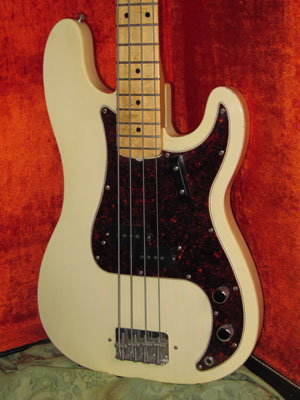



|
FENDER PRECISION BASS SLAB-BODY, 1967 Sources: Most informations about this model and this specific instrument are provided by Barry Matthews' book "Fender Bass For Britain", Authorhouse, 2009 - and kindly updated and revised by the same Author, whom we sincerely wish to thank. This instrument is discussed and pictured at pages 38-39. Furthermore, the noted US magazine Vintage Guitar has published an article by Peter Kohman in its January 2009 issue, where this instrument is pictured at page 72. Early in 1966 the Arbiter (later Dallas/Arbiter) Ltd company, which imported Fender instruments in the United Kingdom, announced the introduction of a new Fender bass, described in Beat Instrumental as featuring a "Telecaster-style" body. It was basically an uncontoured ash-body Precision Bass with a see-through "tele-blond" finish. The model, initially conceived for the British market only, was roughly modeled after the original '50s Precision, with a maple fretboard and a black pickguard, anticipating the introduction of Telecaster Bass. The research thoroughly conducted by Barry Matthews, who through the years has identified, located and inspected many of the extant "slab-bodied" Precisions, has shown that these bodies were probably produced by Fender in a 25-unit batch, which was the minimum batch number for a specific version of a Fender model. All these bodies were probably produced between April and May 1966. At least 17 of these basses were actually shipped to the United Kingdom. All of them featured a "maple-cap" neck, taken from the regular production line of the Precision model, with C width and production dates ranging from August 1965 to October 1966. These basses had a black pickguard (although a three-ply 'guard, unlike the '50s P-Bass), Kluson tuning machines and potentiometers dating from 7th to 18th week of '66. The "musical" history of this rare model is notable, especially for its association with the legendary John Entwistle, bassist of The Who, who purchased (and destroyed) two. Not completely, though: in fact, the neck from his second slab-Precision was immediately reused for the assemblage of "Frankenstein", the bass which became the artist's first-choice instrument through all his career. Beside Entwistle, also Chip Hawkes of the Tremeloes used a "slab" during the most successfull period of the band, but this bass too was lost in a fire. And another "slab" was often used by, Steve Currie, bassist of T-Rex. An even rare variant of the slab-body Precision is the one shown here. A very limited batch of instruments (Matthews has identified seven) was not shipped overseas and was equipped with a regular tortoise pickguard to be finally sold on the US market - almost exclusively by Manny's. Two of them even have a rosewood board, departing radically from the '50s tele-look of the UK version, like the one used by black R&B bass player Bob West. The instrument you see here has very special features. It's completely original except for a good refret job, a replaced nut and a tiny plugged hole from an added string retainer on the headstock's face. All the solder-joints of the electric circuitry are untouched and nothing has ever been modified on the instrument. Matthews describes it as the last of the slab-body Precisions and several details discovered by us seem to confirm this idea. The blond-finished ash body has the same (2) stamp found on all the other extant slab-Precisions, which is associated with Virgilio Simoni, the employee who took care of the final inspection of all the slab bodies at Fender's factory. The pots are dated 18th and 31st week of '66; while the first is common to all the other instruments from the same production batch, the latter is the later ever found on a slab-bass. And there is another detail that identifies this bass as a very late model: the pickup, split in two units, is composed by an old style black-bottom with no date, and a grey-bottom with a pencil date reading May 17th 1967. This fact confirms that the bass has left Fender's factory around mid- '67, as also confirmed by the F-188559 serial number. The maple-cap neck has no date, although it shows many of the stamps and signs typical of the mid-60s. Finally, among all the slabs identified by Matthews, this is the only one fitted with the large oval-button tuning machines, rarely seen on Precisions only in the second half of the '60s. This
rare and precious bass was purchased in the late '60s by
multi-instrumentalist Eric
Weissberg,
who used it in a long and illustrious career highlighted by sessions and
gigs with Art Garfunkel, Doc Watson,
Clarence White, Bob Dylan, Talking Heads, Herbie Mann, Johnny Cash... An
instrument with a long and happy life of music, which we are proud to
display on our web pages.
Weissberg remembers:
|

























































